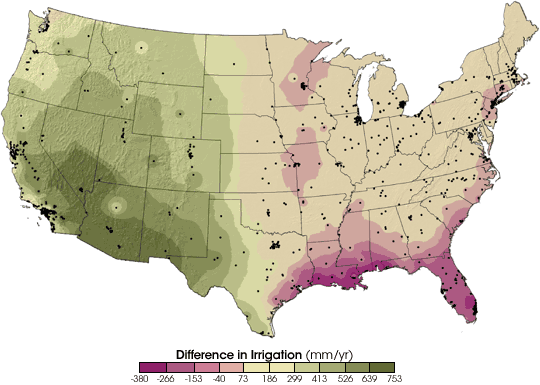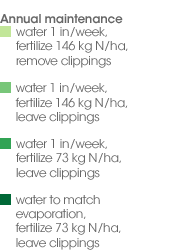| |
Ecological Impact of Lawns |
| |
Recognizing that different people and businesses treat their lawns differently, she had a computer simulate the effect on the water cycle and carbon cycle of different lawn management techniques. The variables the models tested included watering a fixed amount (including rainfall) versus watering according to weather and evaporation rates, adding different amounts of fertilizer, and leaving the clippings on the lawn after mowing or bagging them up.
Water |
|
  |
| |
Some of the results weren’t surprising, explains Milesi. The model confirmed that if people watered according to a fixed amount, about 2.5 centimeters (1 inch) per week minus rainfall, then lawns in rainier places, such as Lincoln Park, Michigan, wouldn’t need any irrigation at all, while Yuma, Arizona, would need the full 2.5 centimeters of irrigation each week.
“If people watered according to what the meteorology indicated, factoring in temperature and humidity, for example, then it would improve irrigation efficiency—use less water—in the Southeast, where humidity is high. But in the West, there is so much sun and humidity is so low that plants can evaporate a lot more than 1 inch of water a week.” In the West, if people watered according to evaporation rates, the model predicts they would need to water nearly 200 centimeters per year. |
|
|
| |
 |
| |
Why is important to know how much water we use to irrigate our lawns? Across the United States, water supplies are increasingly under pressure as populations grow. The water table has dropped hundreds of feet in many locations, and rivers and streams go dry for long stretches in various seasons as water is siphoned off for agriculture, industry, and individual residences. All along the Atlantic seaboard from Florida to New York, saltwater is flowing into formerly freshwater aquifers and wells because we are pumping freshwater out faster than nature can put it back.
Given these pressures, says Milesi, it’s important to think about how society uses the available water. “Depending on the irrigation schemes I portrayed with the computer simulations, whether you choose a fixed amount or choose an amount tied to weather and evaporation, domestic and commercial water use for lawns would be 695 to 900 liters (184 to 238 gallons) per person per day if all lawns [in the Lower 48] were well-watered.” That means about 200 gallons of fresh, usually drinking-quality water per person per day would be required to keep up our nation’s lawn surface area.
Carbon |
|
Milesi modeled the effect of watering a fixed amount of 1-inch per week or watering based on environmental conditions that affect the rate of evaporation of water from plants and soil, such as temperature and relative humidity. This map shows where watering according to environmental conditions would decrease water use (pink areas) or increase it (green). Not surprisingly, the amount of water required to keep pace with evaporation in the South, where humidity is high, is much less than the amount required in the West, where humidity is low. (Image courtesy Cristina Milesi.) |
| |
After running a series of model simulations using different amounts of fertilizer, watering schedules, and leaving or removing the cut grass after mowing, Milesi says that a well-watered and fertilized lawn is a carbon sink. If people recycle the grass clippings, leaving them to decompose on the lawn, the U.S. lawn area could store up to 16.7 teragrams of carbon each year. That’s equivalent to about 37 billion pounds—the weight of about 147,000 blue whales. Even if people bag their grass clippings and compost them off site, (many cities now collect and compost yard waste as part of the waste management program), lawn surfaces still appear to be a carbon sink, although at a much smaller rate of about 5.9 teragrams of carbon per year. (If the clippings decompose in a landfill, however, all bets are off, as the oxygen-poor environment increases production of carbon-containing methane, a potent greenhouse gas.)
The fact that recycling the clippings on the lawn would be so productive is a little surprising, according to Milesi. After all, decomposing grass is a source of carbon, with bacterial activity releasing carbon dioxide back into the atmosphere. But apparently, grass is more efficient than Milesi expected. The growth boost provided by the recycling of nitrogen from the decomposing grass clippings more than makes up for the carbon being released. |
|
|
| |
 |
|
 |
| |
“In fact, the model suggests that if we recycle the clippings on the grass, we can almost halve the amount of synthetic nitrogen fertilizer, and the carbon storage is still greater than it would be if we used the higher amounts of fertilizer but removed the clippings from the lawn.” That could be good news for estuaries and other coastal areas where runoff of excess nitrogen from land surfaces is major source of water pollution, leading to algae overgrowth and dead zones, where aquatic life can’t survive.
Having real numbers to describe the impact of human-designed landscapes is important to scientists. But just as interesting to Milesi was one of her more descriptive findings: in most of the United States, lawns just aren’t natural. When she had the ecosystem computer models generate a “control” scenario in which lawns were not irrigated or fertilized, she says, “The only places I could grow grass in the conterminous U.S. were a few areas in the Northeast and the Great Plains.” Everywhere else, lawns have to be coddled to keep them going and to keep weeds and other plants from taking over.
In parts of the West, many cities are already trying to encourage people to stop coddling their lawns through incentives for xeriscaping (landscaping with an eye toward water conservation, using native or drought-tolerant plants, well designed irrigation systems, and stone) as well as through fines and other penalties for violating city-mandated watering schedules.
 Future Plans Future Plans
 More Lawns than Irrigated Corn More Lawns than Irrigated Corn
|
|
Different lawn maintenance scenarios (green bars) resulted in different amounts of total carbon storage in lawns. The graph above shows (left to right) the major parts of the carbon cycle in lawns: carbon taken in during photosynthesis, carbon contained in grass clippings, and carbon lost as carbon dioxide during decomposition processes in the soil. Lawns that received at least one inch of water per week, 146 kilograms of nitrogen fertilizer per hectare, and had the grass clippings left on the ground to naturally decompose stored the most carbon, about 17 teragrams per year. Black lines show the range of variability in the estimates. (Image adapted from Milesi et al.) |

